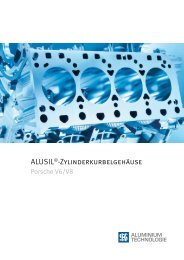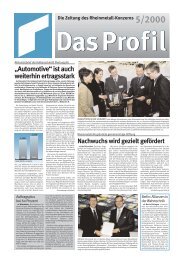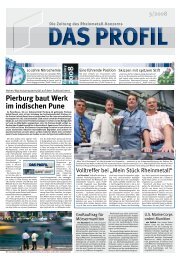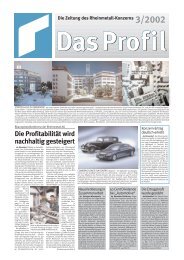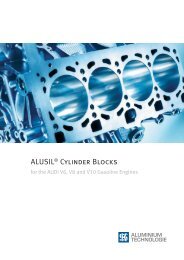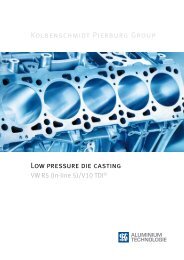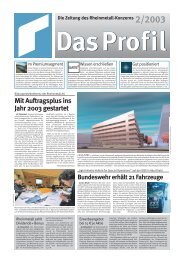PDF [1.1 MB] - KSPG AG
PDF [1.1 MB] - KSPG AG
PDF [1.1 MB] - KSPG AG
Create successful ePaper yourself
Turn your PDF publications into a flip-book with our unique Google optimized e-Paper software.
Kassel/Kiel. Right on schedule, the German Army’s first<br />
Puma infantry fighting vehicle (IFV) is set to roll off the assembly<br />
lines of Rheinmetall Landsysteme and Krauss-<br />
Maffei Wegmann just before Christmas 2005. Representing<br />
an entirely new departure in armored vehicle design,<br />
the Puma once again places Germany’s army technology<br />
industry on the global cutting edge, bolstering its leading<br />
position in this domain. The Puma vehicle concept is<br />
unlike any other, with numerous characteristics that<br />
make it the world’s safest, most secure IFV. The new<br />
Newsline<br />
Germany’s biggest procurement project right on schedule<br />
The Puma IFV is ready to pounce<br />
he first roadworthy Puma<br />
will be presented to the<br />
Bundeswehr on December<br />
20, 2005 in Kassel. RLS’s<br />
plants in Kiel, Kassel and<br />
Gersthofen (near Augsburg)<br />
are all involved in<br />
the project, as are KMW’s Kassel and<br />
Munich plants. The teamwork has been<br />
impressive: based on the PSM concept<br />
Rheinmetall Landsysteme engineered<br />
the Puma’s chassis in Kiel. The same is<br />
true of initial work on the hull, ultimately<br />
supplied by B+V Industrietechnik,<br />
a Hamburg company that specializes<br />
in welding steel armor. “Our expertise<br />
is what makes it possible to<br />
turn all this into an advanced IFV. The<br />
complete system integration of the<br />
GSD chassis is in the hands of RLS”,<br />
declares Helge Möller, 44, in charge of<br />
developing and engineering the Puma.<br />
The power pack, electronics, heating<br />
and climate control technology are all<br />
integrated in Kiel.<br />
KMW manufactures the turret in Kassel,<br />
as well as the individual crew stations,<br />
which in the Puma are integrated<br />
into the hull. Its main armament comes<br />
from RLS’s Gersthofen plant, consisting<br />
of the MK 30-2/ABM automatic cannon<br />
made by Rheinmetall Waffe Munition<br />
GmbH in Oberndorf.<br />
In order to commission the complete<br />
system, in mid November 2005 the<br />
demonstrator version will be taken<br />
over from RLS in Kassel.<br />
“The Puma is equipped with an advanced<br />
high-power density (HPD)<br />
diesel power pack featuring high integration<br />
density, specially developed by<br />
MTU. The engine has an 800 kW output;<br />
there is also a starter generator between<br />
the engine and the transmission,<br />
which can crank out up to 170 kW in<br />
power”, states Helge Möller, a trained<br />
mechanical engineer. According to<br />
Möller, there’s never a dull moment<br />
these days: “Being part of the country’s<br />
biggest army technology program is an<br />
exciting challenge” – all the more so<br />
since the project has progressed at a<br />
record pace. As Möller recounts, “all of<br />
the main companies (for example, RLS,<br />
KMW, MTU and Renk) involved in developing<br />
and engineering the Puma use<br />
3D CAD systems. This means that the<br />
participating companies generate all<br />
the components and subassemblies as<br />
3D models, which they can then exchange.”<br />
As a result, interfaces can be<br />
studied and identified at an early stage,<br />
and steadily refined during the development<br />
process – right up until the final<br />
binding specification.<br />
In organizing this process, PSM<br />
GmbH has had to take into account the<br />
stringent, highly heterogeneous requirements<br />
the new IFV will have to<br />
6<br />
system is thus a clear investment in the security and<br />
future effectiveness of the German Army, which will be<br />
the first to field it. Close cooperation between Rheinmetall<br />
Landsysteme GmbH (RLS), Krauss-Maffei Wegmann<br />
GmbH & Co. KG (KMW) and their subcontractors<br />
made for a quick development phase. The company Projekt<br />
System & Management GmbH (PSM) of Kassel, a<br />
joint venture of RLS and KMW, is in charge of the project,<br />
which brings together the expertise of two of Europe’s leading<br />
makers of light and heavyweight armored vehicles.<br />
Peter Hellmeister: “Our mission is to build the world’s best infantry fighting vehicle.”<br />
meet. “In order to combine the utmost<br />
in crew protection with complete airportability,<br />
we had to develop a totally<br />
new armor concept”, recalls Dr. Peter<br />
Hellmeister, 53, one of PSM GmbH’s<br />
two managing directors. The Puma features<br />
two levels of protection: in Protection<br />
Level A (Airportable), the vehicle<br />
is light enough to be airlifted yet<br />
still offers the world’s best protection<br />
against landmines; to achieve Protection<br />
Level C (Combat), separately airportable<br />
add-on armor elements can<br />
be fitted to the vehicle as soon as it<br />
reaches the area of operations, reliably<br />
protecting it from rocket propelled<br />
grenades. The lateral protection elements<br />
can be folded down after mounting,<br />
meaning that the Puma can be<br />
transported by rail even when configured<br />
for combat. “When it comes to<br />
ballistic and landmine protection,<br />
we’re the best worldwide”, affirms<br />
Hellmeister, who began his career at<br />
(Continued on page 7)<br />
Photo: Annette Kaduhr


![PDF [1.1 MB] - KSPG AG](https://img.yumpu.com/4218345/6/500x640/pdf-11-mb-kspg-ag.jpg)
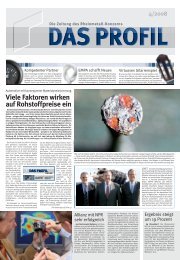
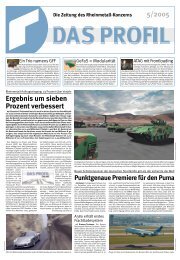
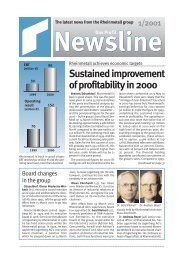

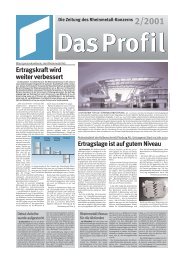
![PDF [1.0 MB] - KSPG AG](https://img.yumpu.com/5513074/1/171x260/pdf-10-mb-kspg-ag.jpg?quality=85)
